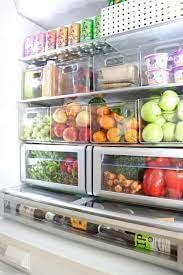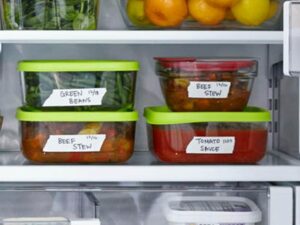When you display food in ice the food must approximately shoppers don’t realize that the quality of the seafood and meat they purchase is often hidden from view when it’s packaged in certain ways. For example, if fish is displayed in ice at a store, it’s only good if the packaging is clear so that shoppers can see what they’re buying.
Keep your food clean
To keep your food clean, use a cover or shield. Ice is a great way to keep your food away from contaminants like dust, moisture, and insects. But beware – ice can also attract pests. If you’re using ice to display your food, make sure you cover it with plastic wrap or foil before putting it in the cooler.
Storing food

When storing food, it’s important to keep it at a cold temperature to prevent spoilage. Ice is an effective way to keep food cold, but only if the food is kept at the right temperature. To maintain a cold temperature, keep foods out of direct sunlight and away from hot surfaces like stoves or grills. When using ice for chilling, use as little as possible to keep foods at 40 degrees Fahrenheit (4 degrees Celsius).
There are many ways to protect your food, such as covering it, shielding it, or displaying it in ice. If you opt to display your food in ice, it is important to also use a cover or shield to protect the food from contaminants.
When you want to keep food cold using ice, it’s important to use a cover or shield to protect the food. The USDA recommends using a full-size sheet pan or over-sized disposable pan. If you’re using plastic wrap to secure your product, you don’t need to wrap it around the entire thing. Instead, place the sheet pan over the top of your product and press down on the four corners to secure it. You can use weights, like cans or jars of water, to keep it in place on the bottom of the pan.
Only Use Water That Is Safe to Drink for Ice
If you’re going to use ice to display food, you need to make sure that the water you use is safe to drink. This means that there should be no contaminants such as chlorine or fluoride present. If there are any contaminants present, they will leach into the food and contaminate it.
The best way to avoid getting sick from your ice is to use bottled water. Bottled water is often advertised as “purified” which means that the water has been treated with reverse osmosis or distillation. These treatments remove all contaminants from the water, making it much safer to consume.
If you don’t have bottled water available, you can filter tap water through a Brita filter or other type of filter designed for drinking water. This will ensure that the water is safe to drink.

When displaying food in ice, it is important to use water that is safe to drink. Water used in ice should be filtered and purified by distillation or reverse osmosis. It should also be acidified with citric acid to a pH of 4.0-6.0. This will prevent the growth of pathogens such as Salmonella, Shigella and Listeria monocytogenes.
If you are using tap water to make ice, it is important to make sure that the water has been treated properly. This is to ensure that your food products retain their flavor and quality, and that your customers’ health is not at risk. Do not use chlorine bleach or baking soda to treat the water, as these can both alter the taste of your food products. If they come in contact with certain foods, they can also cause chemical reactions that might harm your product or your customers’ health.
Only buy ice from a trustworthy source

You should only buy ice from a trustworthy source. There are many reasons why people use ice to display food. Sometimes, you need to show off your best products in a way that makes them look appetizing and inviting.
Other times, you want your food to be cold but not frozen, so that it doesn’t lose its texture or flavor. By ensuring that you only purchase ice from a reputable source, you can be sure that your food will be kept at the optimal temperature and won’t lose its flavor or texture. Ice can serve both purposes, only if you buy from a dependable source.
When purchasing ice from any source
It’s important to make sure that the product is coming from a reputable and trustworthy source. If you’re buying ice from a local store or restaurant, you can typically assume that the quality of the product is good. However, if you’re buying ice from an online vendor or wholesaler, there’s always the possibility that the product isn’t as pure as it should be. When in doubt, it’s always best to err on the side of caution and purchase your ice from a trusted source.
If you have any doubts about a vendor
consider these questions: Do they offer a money-back guarantee? If so, how long is the window for this guarantee? What’s the refund policy for customers? How much do they charge for shipping? What are their policies when it comes to lost or damaged packages? Is free shipping available for orders that exceed a certain amount? These are important factors to consider when making a decision about whether or not to do business with a vendor.
To keep food and drink safe from contamination during transport, storage, and display, take the following precautions:

-Keep food covered at all times -Transport food in clean, covered containers
-Store food in clean, covered containers
-Display food on clean surfaces
Food businesses must take care to protect their food from any possible contamination during transport, storage, and display. This includes:
-Making sure that food is transported in clean and covered vehicles
-Storing food in clean and appropriate containers
-Displaying food in a way that minimizes the risk of contamination (e.g., using sneeze guards)
When displaying food in ice
you must make sure that the food is still edible for consumers when served. Additionally, all surfaces of the food must be frozen or chilled at or below 41°F (5°C). When assembling the food in ice, make sure to pack the food tightly together so there are no spaces in between pieces of food.
Wrap the food in plastic wrap or place

When you’re displaying food in ice, make sure to place the food in a way that minimizes drip loss. If the food is displayed on top of the ice, it will drip and cause a mess on the countertop. To avoid this, either wrap the food in plastic wrap or place it in a plastic container before placing it on top of the ice block.
When displaying food in ice, make sure to leave at least 1/2 inch (1 cm) of space between each piece. This will help prevent the pieces from sticking together and making a mess when they start to melt.
Final thought
The food industry uses ice to keep foods fresh, as a way to cool drinks on a hot summer day, and for an exciting presentation. However, it is important to understand the potential dangers of using ice with foods and how you can use ice safely to display food. If you keep these three key points in mind when displaying food in ice, you can use ice without harming anyone.

